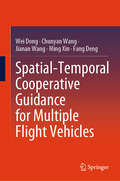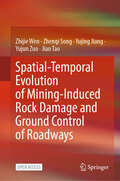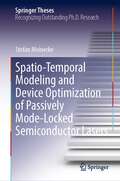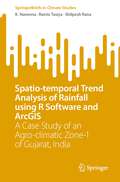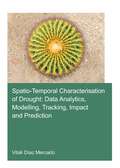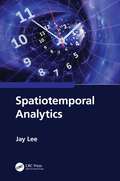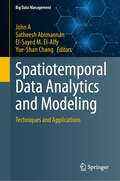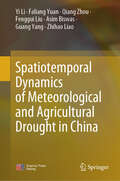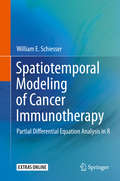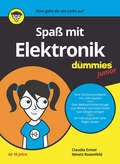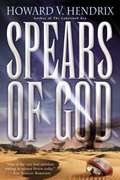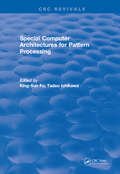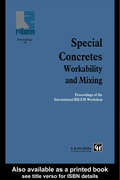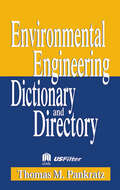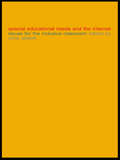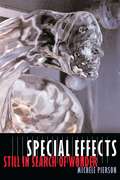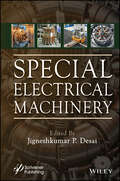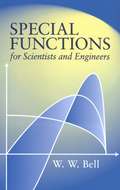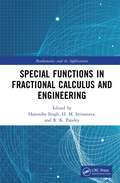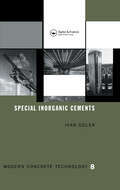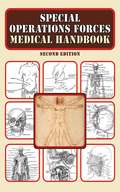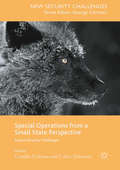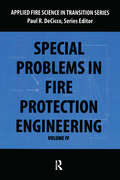- Table View
- List View
Spatial Variation of Seismic Ground Motions: Modeling and Engineering Applications (Advances in Engineering Series)
by Aspasia ZervaThe spatial variation of seismic ground motions denotes the differences in the seismic time histories at various locations on the ground surface. This text focuses on the spatial variability of the motions that is caused by the propagation of the waveforms from the earthquake source through the earth strata to the ground surface, and it brings toge
Spatial-Temporal Cooperative Guidance for Multiple Flight Vehicles
by Ming Xin Wei Dong Chunyan Wang Fang Deng Jianan WangThe spatial-temporal cooperative guidance problem for multiple flight vehicles has garnered significant attention in recent years due to its potential benefits in both military and civil fields. This book provides a concise but holistic introduction to this practical problem and presents a summative collection of the latest solutions to the concerned challenges, thereby providing some theoretical support for enhancing the synergism and applicability of cooperative guidance for multiple flight vehicles. This book consists of nine chapters. In Chapter 1, recent works on cooperative guidance are systematically recalled. Chapter 2 introduces the common formulation and unique challenges of the cooperative guidance problem from a practical viewpoint. In Chapter 3, a varying-gain proportional navigation guidance law with accurate time-to-go prediction is developed to realize precise control of the impact time. In Chapter 4, in response to the inherent finite-time property of the cooperative guidance problem, a fixed-time convergent error dynamic is proposed to design a 3D distributed cooperative guidance law with enhanced convergence. In Chapter 5, a command-decoupled design strategy is proposed to address the challenging spatial-temporal cooperative guidance problem through the derivation and combination of the coplanar cooperative guidance and planar pursuit guidance commands. In Chapter 6, an integrated design strategy based on rotational operations on spatial vectors is proposed to simultaneously satisfy the impact angle and time constraints. In Chapter 7, a multiple-stage cooperative guidance strategy is developed to satisfy the spatial-temporal constraints without relying on time-to-go information. In Chapter 8, a unified command augmentation method is proposed to prevent the seeker's FOV from exceeding the boundary throughout the cooperative guidance. Finally, Chapter 9 concludes this book and offers an instructive opinion on the future directions of the cooperative guidance problem in both academic and engineering investigations. Therefore, this book can not only serve as a reference for researchers who are interested in this field with systematic and inspirational perspectives, but also be a useful handbook for engineers engaged in cooperative guidance and control of multiple flight vehicles.
Spatial-Temporal Evolution of Mining-Induced Rock Damage and Ground Control of Roadways
by Jian Tao Yujing Jiang Zhijie Wen Zhenqi Song Yujun ZuoThis open access book presents the Coal remains the primary energy source in China, with an estimated total coal reserve of 59 trillion tons at depths of less than 2000 meters. Among these, over 50% lie at depths exceeding 1000 meters, primarily distributed in central and eastern China. Deep coal mining has become the new norm for the coal industry&’s development and resource exploitation. To ensure energy supply for the rapid economic development of central and eastern regions, mining coal resources from depths of over 1000 meters is inevitable. This endeavor holds significant strategic importance for safeguarding national energy security and supporting regional economic growth. However, mining-induced hazards, such as rock bursts, water inrushes, and roof collapses, continue to occur frequently in both local and state-owned coal mines. These incidents pose severe threats to the safety of coal production, tarnish the reputation of China's mining industry, and hinder its development. Therefore, advancing mining engineering—especially the theories of major accident prediction and control—is essential. A deeper understanding of the dynamic processes underlying mining-induced pressure and strata movement is necessary. Promoting safe and efficient coal mining through informed decision-making and management supported by scientific, quantitative methods is a critical and urgent task. Achieving informatization, intelligence, and visualization in mining operations will be key to fundamentally addressing the current safety challenges in China's mining industry. In recent years, the author and their team have conducted in-depth studies on models of dynamic disasters and surrounding rock control in deep mines, supported by projects under the National Basic Research Program (973 Program), the National Key R&D Program, as well as talent and general research funds and specialized consultancy projects from the Chinese Academy of Sciences. The main research focuses include constructing spatial structural models of overlying strata in mining areas, analyzing the spatiotemporal evolution of mining-induced stress, and developing proactive control technologies for dynamic disasters in mining areas. This book aims to provide foundational insights into the occurrence and control of major mining accidents. It proposes a decision-making framework for predicting and managing such disasters by controlling the movement of surrounding rock and stress conditions induced by mining. These efforts are expected to provide a reference for advancing research in related fields.
Spatially Resolved Characterization in Thin-Film Photovoltaics
by Matevž Bokalič Marko TopičThe book is devoted to the spatial characterization of solar cells and PV modules. It is written both as a monograph as well as a succinct guide for the state-of-the-art spatial characterization techniques and approaches. Amongst the approaches discussed are visual imaging, electro- and photo-luminescence imaging, thermography, and light beam induced mapping techniques. Emphasis is given on the luminescence image acquisition and interpretation due to its great potential. Characterization techniques are accompanied by simulation tools. The contents are aimed at a readership of students and senior researchers in R&D as well as engineers in industry who are newcomers to the spatial characterization of either solar cells or PV modules. The concepts and approaches presented herein are based on but not limited to case studies of real thin-film PV devices. Key features: Review of spatially resolved characterization techniques and accompanying SPICE simulations in photovoltaics Use of spatially resolved characterization techniques and their combinations for the identification of inhomogeneities in small area CdTe and dye-sensitized solar cells Case studies of electroluminescence imaging of commercial PV modules (c-Si, CIGS, CdTe, a-Si, tandem and triple junction thin-film-Si) The contents are aimed at a readership of students and senior researchers in R&D as well as engineers in industry who are newcomers to the spatial characterization of either solar cells or PV modules. The concepts and approaches presented herein are based on but not limited to case studies of real thin-film PV devices. Key features: Review of spatially resolved characterization techniques and accompanying SPICE simulations in photovoltaics Use of spatially resolved characterization techniques and their combinations for the identification of inhomogeneities in small area CdTe and dye-sensitized solar cells Case studies of electroluminescence imaging of commercial PV modules (c-Si, CIGS, CdTe, a-Si, tandem and triple junction thin-film-Si)
Spatio-Temporal Modeling and Device Optimization of Passively Mode-Locked Semiconductor Lasers (Springer Theses)
by Stefan MeineckeThis thesis investigates passively mode-locked semiconductor lasers by numerical methods. The understanding and optimization of such devices is crucial to the advancement of technologies such as optical data communication and dual comb spectroscopy. The focus of the thesis is therefore on the development of efficient numerical models, which are able both to perform larger parameter studies and to provide quantitative predictions. Along with that, visualization and evaluation techniques for the rich spatio-temporal laser dynamics are developed; these facilitate the physical interpretation of the observed features.The investigations in this thesis revolve around two specific semiconductor devices, namely a monolithically integrated three-section tapered quantum-dot laser and a V-shaped external cavity laser. In both cases, the simulations closely tie in with experimental results, which have been obtained in collaboration with the TU Darmstadt and the ETH Zurich. Based on the successful numerical reproduction of the experimental findings, the emission dynamics of both lasers can be understood in terms of the cavity geometry and the active medium dynamics. The latter, in particular, highlights the value of the developed simulation tools, since the fast charge-carrier dynamics are generally not experimentally accessible during mode-locking operation. Lastly, the numerical models are used to perform laser design explorations and thus to derive recommendations for further optimizations.
Spatio-temporal Trend Analysis of Rainfall using R Software and ArcGIS: A Case Study of an Agro-climatic Zone-1 of Gujarat, India (SpringerBriefs in Climate Studies)
by K. Naveena Ramiz Tasiya Shilpesh RanaThis book aims to provide an advanced R software approach that can carry out rainfall trend analysis using Mann-Kendall and Sen’s slope estimator tests. The research study follows a systematic approach while utilizing R software as it can greatly facilitate the analysis of rainfall trends. About 30 stations located in the study area and 41 to 50 years’ time series were selected for the purpose of analysis. The data for the research was collected from the State Water Data Centre (SWDC) in Gujarat, Indian Meteorological Department (IMD) in Pune, DAAC (NASA), and ESRI. Cluster analysis has been performed to analyze the variability of the mean rainfall. The stations have been divided into 2 clusters with 17 and 13 stations in each cluster which significantly differ from each other. This book is aimed at researchers, scientists and government organizations working in the field of climate change.
Spatio-temporal characterisation of drought: data analytics, modelling, tracking, impact and prediction (IHE Delft PhD Thesis Series)
by Vitali Diaz MercadoStudies of drought have increased in light of new data availability and advances in spatio-temporal analysis. However, the following gaps still need to be filled: 1) methods to characterise drought that explicitly consider its spatio-temporal features, such as spatial extent (area) and pathway; 2) methods to monitor and predict drought that include the above-mentioned characteristics and 3) approaches for visualising and analysing drought characteristics to facilitate interpretation of its variation. This research aims to explore, analyse and propose improvements to the spatio-temporal characterisation of drought. Outcomes provide new perspectives towards better prediction. The following objectives were proposed. 1) Improve the methodology for characterising drought based on the phenomenon’s spatial features. 2) Develop a visual approach to analysing drought variations. 3) Develop a methodology for spatial drought tracking. 4) Explore machine learning (ML) techniques to predict crop-yield responses to drought. The four objectives were addressed and results are presented. Finally, a scope was formulated for integrating ML and the spatio-temporal analysis of drought. Proposed scope opens a new area of potential for drought prediction (i.e. predicting spatial drought tracks and areas). It is expected that the drought tracking and prediction method will help populations cope with drought and its severe impacts.
Spatiotemporal Analytics
by Jay LeeThis book introduces readers to spatiotemporal analytics that are extended from spatial statistics. Spatiotemporal analytics help analysts to quantitatively recognize and evaluate the spatial patterns and their temporal trends of a set of geographic events or objects. Spatiotemporal analyses are very important in geography, environmental sciences, economy, and many other domains. Spatiotemporal Analytics explains in very simple terms the concepts of spatiotemporal data and statistics, theories, and methods used. Each chapter introduces a case study as an example application for an in-depth learning process. The software used and the codes provided enable readers not only to learn statistics but also to use them effectively in their projects. • Provides a comprehensive understanding of spatiotemporal analytics to readers with minimum knowledge in statistics. • Written in simple, understandable language with step-by-step instructions. • Includes numerous examples for all theories and methods explained in the book covering a wide range of applications from different disciplines. • Each application includes a software code needed to follow the instructions. • Each chapter also has a set of prepared PowerPoint slides to help spatiotemporal analytics instructors explain the content. Undergraduate and graduate students who use Geographic Information Systems or study Geographical Information Science will find this book useful. The subject matter is also pertinent to an array of disciplines such as agriculture, anthropology, archaeology, architecture, biology, business administration and management, civic engineering, criminal justice, epidemiology, geography, geology, marketing, political science, and public health.
Spatiotemporal Data Analytics and Modeling: Techniques and Applications (Big Data Management)
by El-Sayed M. El-Alfy John A Satheesh Abimannan Yue-Shan ChangWith the growing advances in technology and transformation to digital services, the world is becoming more connected and more complex. Huge heterogeneous data are generated at rapid speed from various types of sensors. Augmented with artificial intelligence and machine learning and internet of things, latent relations, and new insights can be captured helping in optimizing plans and resource utilization, improving infrastructure, and enhancing quality of services. A “spatial data management system” is a way to take care of data that has something to do with space. This could include data such as maps, satellite images, and GPS data. A temporal data management system is a system designed to manage data that has a temporal component. This could include data such as weather data, financial data, and social media data. Some advanced techniques used in spatial and temporal data management systems include geospatial indexing for efficient querying and retrieval of location-based data, time-series analysis for understanding and predicting temporal patterns in datasets like weather or financial trends, machine learning algorithms for uncovering hidden patterns and correlations in large and complex datasets, and integration with Internet of Things (IoT) technologies for real-time data collection and analysis. These techniques, augmented with artificial intelligence, enable the extraction of latent relations and insights, thereby optimizing plans, improving infrastructure, and enhancing the quality of services. This book provides essential technical knowledge, best practices, and case studies on the state-of-the-art techniques of artificial intelligence and machine learning for spatiotemporal data analysis and modeling. The book is composed of several chapters written by experts in their fields and focusing on several applications including recommendation systems, big data analytics, supply chains and e-commerce, energy consumption and demand forecasting,and traffic and environmental monitoring. It can be used as academic reference at graduate level or by professionals in science and engineering related fields such as data science and engineering, big data analytics and mining, artificial intelligence, machine learning and deep learning, cloud computing, and internet of things.
Spatiotemporal Dynamics of Meteorological and Agricultural Drought in China
by Yi Li Guang Yang Asim Biswas Faliang Yuan Qiang Zhou Fenggui Liu Zhihao LiaoThis book explores spatiotemporal analysis and impact assessment of agricultural drought in China and investigates the correlation coefficient between meteorological drought and agricultural drought. It then conducts multivariate frequency analysis of drought events using drought indices and copula functions. It aims to reveal spatiotemporal characteristics and impacts of agricultural drought in China both on vegetation phenology and productivity. The book assesses the performances of drought indices for better predicting multi-year droughts and return periods and drought risk assessment.
Spatiotemporal Modeling of Cancer Immunotherapy: Partial Differential Equation Analysis in R
by William E. SchiesserThe focus of this book is a detailed discussion of a dual cancer vaccine (CV)-immune checkpoint inhibitor (ICI) mathematical model formulated as a system of partial differential equations (PDEs) defining the spatiotemporal distribution of cells and biochemicals during tumor growth.A computer implementation of the model is discussed in detail for the quantitative evaluation of CV-ICI therapy. The coding (programming) consists of a series of routines in R, a quality, open-source scientific computing system that is readily available from the internet. The routines are based on the method of lines (MOL), a general PDE algorithm that can be executed on modest computers within the basic R system. The reader can download and use the routines to confirm the model solutions reported in the book, then experiment with the model by varying the parameters and modifying/extending the equations, and even studying alternative models with the PDE methodology demonstrated by the CV-ICI model.Spatiotemporal Modeling of Cancer Immunotherapy: Partial Differential Equation Analysis in R facilitates the use of the model, and more generally, computer- based analysis of cancer immunotherapy mathematical models, as a step toward the development and quantitative evaluation of the immunotherapy approach to the treatment of cancer.
Spaß mit Elektronik für Dummies Junior (Für Dummies)
by Claudia Ermel Ninett RosenfeldBastelst du gern? Und liebst du es, wenn es leuchtet, piept und blinkt? In diesem Buch erfährst du Schritt für Schritt, wie du mit LEDs, Kondensatoren, Transistoren, Widerständen und anderen elektronischen Bauteilen nützliche und schöne Dinge wie Glückwunschkarten, Geschicklichkeitsspiele, Gespenster, Weihnachtsschmuck und Spielzeugautos basteln kannst. Du wirst von Anfang an auch löten! Nebenher lernst du, was Strom ist, warum man dafür Spannung braucht und wie alles funktioniert. Die Bauteile kannst du dir für wenig Geld im Internet oder im Elektronikmarkt besorgen. Leg einfach los! Bestens geeignet für Kinder und Jugendliche ab 10 Jahren.
Spears of God
by Howard V. HendrixIn the early decades of the twenty-first century, the most commonly held truth is that knowledge is power. Yet a select few men and women begin to suspect what few will admit: we know nothing at all. The world’s oil resources have dwindled. The rich are turning richer and the power-mongers are becoming more powerful. China and the United States dominate the globe in a geopolitical chess match. The human mind has merged with the cybergrid, yet the human race seems not to have evolved much at all. ...
Special Computer Architectures for Pattern Processing
by King-Sun FuIt has been recognized for a long time that a conventional sequential processor is inefficient for operations on pictorial data where relatively simple operations need to be performed on a large number of data elements (pixels). Though many parallel processing architectures for picture processing have been proposed in the past, very few have actually been implemented due to the costs involved. With LSI technology, it is becoming possible to realize parallel architectures at a modest cost. In the following the authors review some of the proposed architectures for pattern recognition and image processing.
Special Concretes - Workability and Mixing
by Peter J.M.BartosThis book forms the Proceedings of the International RILEM Workshop held in Paisley in March 1993. It contains contributions on theoretical and practical aspects of the use of special concretes, with a particular focus on their behaviour in the fresh state.
Special Edition - Environmental Engineering Dictionary and Directory
by Thomas M. PankratzLike most technical disciplines, environmental science and engineering is becoming increasingly specialized. As industry professionals focus on specific environmental subjects they become less familiar with environmental problems and solutions outside their area of expertise. This situation is compounded by the fact that many environmental science
Special Educational Needs and the Internet: Issues for the Inclusive Classroom
by Chris AbbottWith Internet access for every school now a reality, teachers are beginning to explore the use of the Internet in the education of children with special needs. This book describes its benefits for children across the spectrum of special educational needs, from those with physical disabilities or sensory impairment to those with learning or social difficulties.With contributions from leading practitioners in the field, this book addresses the huge range of possibilities the Internet and associated technology offer for these pupils. Combining current theory and debate with practical guidance and inspiring case studies, this book considers:* how the Internet can be used to gather and publish information* how to communicate effectively through technology* policy and management issues for schools* the continuing challenges for access and inclusion.This book will be of interest to all teachers involved in special education needs, in both mainstream and special schools.
Special Effects: Still in Search of Wonder (Film and Culture Series)
by Michele PiersonDesigned to trick the eye and stimulate the imagination, special effects have changed the way we look at films and the worlds created in them. Computer-generated imagery (CGI), as seen in Hollywood blockbusters like Star Wars, Terminator 2, Jurassic Park, Independence Day, Men in Black, and The Matrix, is just the latest advance in the evolution of special effects. Even as special effects have been marveled at by millions, this is the first investigation of their broader cultural reception. Moving from an exploration of nineteenth-century popular science and magic to the Hollywood science fiction cinema of our time, Special Effects examines the history, advancements, and connoisseurship of special effects, asking what makes certain types of cinematic effects special, why this matters, and for whom. Michele Pierson shows how popular science magazines, genre filmzines, and computer lifestyle magazines have articulated an aesthetic criticism of this emerging art form and have helped shape how these hugely popular on-screen technological wonders have been viewed by moviegoers.
Special Electrical Machinery
by Jigneshkumar P. DesaiThis book is a comprehensive guide to specialized motors, providing in-depth information on the operating principles, applications, and controls of various special electrical machines. It covers a range of special machines, including switched reluctance motors, permanent magnet synchronous machines, brushless direct current motor, stepper motors, universal motors, and hysteresis motors. The book also addresses the issue of torque ripple. Much of the literature available today focuses solely on conventional motors and their controls, like induction motors, synchronous motors, PMDC motors, servo machines, and transformers. This book takes a broader view, addressing the growing trend toward specialized motors tailored to specific applications and new innovations in control and modification. It aims to offer comprehensive insights into these special machines by providing detailed information on their operating principles, applications, and controls. This exciting new volume: Provides application-based examples of machines not covered in other books on special machines Provides context for the use of special machines used in electric vehicle technology Gives examples which are helpful for industry practices Audience Undergraduate students, post-graduate students, researchers, and industry professionals who study and use special machines
Special Functions for Scientists and Engineers
by W. W. BellClear and comprehensive, this text provides undergraduates with a straightforward guide to special functions. It is equally suitable as a reference volume for professionals, and readers need no higher level of mathematical knowledge beyond elementary calculus. Topics include the solution of second-order differential equations in terms of power series; gamma and beta functions; Legendre polynomials and functions; Bessel functions; Hermite, Laguerre, and Chebyshev polynomials; Gegenbauer and Jacobi polynomials; and hypergeometric and other special functions. Three appendices offer convenient tabulation of principal results, and a generous supply of worked examples and problems includes some hints and solutions. 1968 edition. 25 figures.
Special Functions in Fractional Calculus and Engineering (Mathematics and its Applications)
by H. M. Srivastava R. K. Pandey Harendra SinghSpecial functions play a very important role in solving various families of ordinary and partial differential equations as well as their fractional-order analogs, which model real-life situations. Owing to the non-local nature and memory effect, fractional calculus is capable of modeling many situations which arise in engineering. This book includes a collection of related topics associated with such equations and their relevance and significance in engineering. Special Functions in Fractional Calculus and Engineering highlights the significance and applicability of special functions in solving fractional-order differential equations with engineering applications. This book focuses on the non-local nature and memory effect of fractional calculus in modeling relevant to engineering science and covers a variety of important and useful methods using special functions for solving various types of fractional-order models relevant to engineering science. This book goes on to illustrate the applicability and usefulness of special functions by justifying their numerous and widespread occurrences in the solution of fractional-order differential, integral, and integrodifferential equations.This book holds a wide variety of interconnected fundamental and advanced topics with interdisciplinary applications that combine applied mathematics and engineering sciences, which are useful to graduate students, Ph.D. scholars, researchers, and educators interested in special functions, fractional calculus, mathematical modeling, and engineering.
Special Inorganic Cements (Modern Concrete Technology)
by Ivan OdlerThe only book to cover the use of special inorganic cements instead of standard Portland cement in certain specialist applications, such as oil well drilling or in a high temperature location. Special Inorganic Cements draws together information which is widely scattered in the technical literature. It describes various special cements, their chemi
Special Operations Forces Medical Handbook
by Department of DefenseThe newest edition of the Special Operations Forces Medical Handbook is perfect and practical for both soldiers and civilians. Nearly 140 comprehensive illustrations show the proper techniques for medical care, from basic first-aid and orthopedics to instructions for emergency war surgery and even veterinary medicine. Questions are listed so that the medic can obtain an accurate patient history and perform a complete physical examination. Diagnoses are made easier with information on the distinctive features of each illness. This straightforward manual is sure to assist any reader faced with a medical issue or emergency.
Special Operations from a Small State Perspective
by Gunilla Eriksson Ulrica PetterssonThis book offers different perspectives on the utilization and development of special operations forces (SOF) in small states. Across the chapters, the authors argue that small states can use and develop this very unique capability both at a tactical and operational level, but also as a strategic instrument in the modern complex security environment. The study finds that SOF in small states has a new role to play and that it needs to become a more agile and flexible force, ready to address future security challenges. A reorientation in favour of SOF from a small state perspective is crucial both due to the changing security situation in Europe, and the need to economise military resources.
Special Problems in Fire Protection Engineering (Applied Fire Science In Transition Ser. #Vol. Iv)
by Paul R DeCiccoFeatures papers directed to fire protection in various environments other than building structures including fuel transporting vehicles, spacecraft, a sports arena, an offshore oil rig and propane fueling bus facilities.

